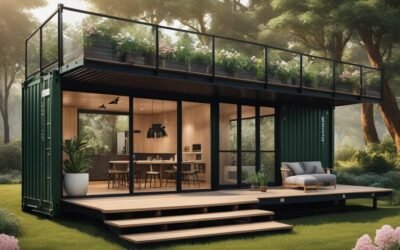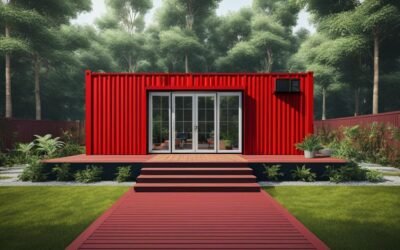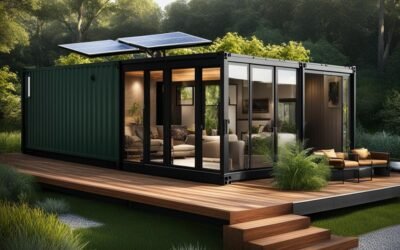When it comes to storage, maximizing space is key. Whether you’re looking to store personal belongings, business inventory, or equipment, it’s important to make the most of the square footage you have available. That’s where shipping containers come in. These large, durable containers offer a versatile storage solution that can be customized to fit your needs.
When selecting a shipping container, it’s essential to consider the available options and assess your storage requirements. By understanding the dimensions and features of different container sizes, you can choose the right container to maximize your space and efficiently organize your belongings.
Key Takeaways:
- Consider the available options and assess your storage needs when selecting a shipping container.
- Standard shipping container sizes range from 10-foot to 40-foot, with each size offering different storage capacities.
- Specialized shipping containers, such as high cube, open-top, and reefer containers, are available for unique storage needs.
- Efficient organization techniques, such as installing shelving and utilizing vertical space, can help maximize the square footage of your container.
- By understanding shipping container sizes and employing effective organization techniques, you can make the most of your storage solution.
Understanding Shipping Container Sizes
Shipping containers come in various sizes, each designed to cater to different storage needs. The most common sizes are 10-foot, 20-foot, and 40-foot containers. These containers have specific dimensions in terms of length, width, and height, which determine their storage capacity. It is important to understand the dimensions of these containers to choose the right size for your storage requirements. Here are the standard dimensions for these three container sizes:
| Container Size | Length | Width | Height |
|---|---|---|---|
| 10-foot | 10 ft | 8 ft | 8.5 ft |
| 20-foot | 20 ft | 8 ft | 8.5 ft |
| 40-foot | 40 ft | 8 ft | 8.5 ft |
It’s worth noting that the exterior measurements may differ slightly from the actual interior space due to the thickness of the container walls. Therefore, it is essential to consider the dimensions when planning the layout and organizing the contents within the container.
When choosing the right shipping container size, take into account the volume of items you need to store or transport. If you are unsure about the dimensions required for your specific needs, considering consulting with a shipping container specialist who can provide guidance based on your requirements.
Standard Shipping Container Sizes
 Standard shipping container sizes, such as 10-foot, 20-foot, and 40-foot containers, are popular choices for various storage needs. When selecting a standard shipping container size, it is essential to consider factors such as available space, budget, and future expansion needs. Understanding the dimensions and storage capacities of these containers can help you make an informed decision.
Standard shipping container sizes, such as 10-foot, 20-foot, and 40-foot containers, are popular choices for various storage needs. When selecting a standard shipping container size, it is essential to consider factors such as available space, budget, and future expansion needs. Understanding the dimensions and storage capacities of these containers can help you make an informed decision.
Here is a guide to the standard shipping container sizes:
10-Foot Container
A 10-foot container offers approximately 560 cubic feet of storage space, making it ideal for residential and small business storage. This compact size allows for easy maneuverability and placement in tight spaces. It’s perfect for storing personal belongings, inventory, or equipment for small businesses.
20-Foot Container
A 20-foot container provides around 1,160 cubic feet of storage space, making it a versatile option for various applications. It offers ample room for storing larger items or multiple smaller items. It’s commonly used for commercial purposes, such as retail storage, construction sites, or as a temporary workspace.
40-Foot Container
A 40-foot container offers approximately 2,350 cubic feet of storage space, making it the go-to choice for larger storage requirements, shipping purposes, or on-site storage solutions. With its spacious interior, it can accommodate significant amounts of goods, making it suitable for industrial storage, international shipping, or warehouse expansions.
By referring to this shipping container size guide, you can determine the right container size based on your specific storage needs. Consider the dimensions, storage capacity, and practicality of each size option to maximize the space and efficiency of your storage solution.
Specialized Shipping Container Sizes
 When it comes to finding the perfect storage solution, standard shipping container sizes may not always meet your specific needs. That’s where specialized shipping containers come in. These containers offer unique dimensions and features that cater to specific storage requirements, providing you with more options to maximize your storage capabilities.
When it comes to finding the perfect storage solution, standard shipping container sizes may not always meet your specific needs. That’s where specialized shipping containers come in. These containers offer unique dimensions and features that cater to specific storage requirements, providing you with more options to maximize your storage capabilities.
Let’s explore some of the specialized shipping container sizes:
1. High Cube Containers
If you need extra vertical space, high cube containers are the ideal solution. These containers are one foot taller than standard containers, providing you with more room to store tall items or stack your belongings vertically. Whether you’re storing furniture, machinery, or other oversized items, high cube containers give you the flexibility to make the most of the available space.
2. Open-Top Containers
For easy loading and unloading of oversized items, open-top containers are the perfect choice. Unlike standard containers, these specialized containers have a removable top, allowing you to transport or store goods that exceed the height of a standard container. The open-top design enables crane or forklift access, making it convenient to load and unload items with ease.
3. Reefer Containers
When it comes to temperature-controlled storage, reefer containers are designed to meet your needs. These containers are equipped with refrigeration units, allowing you to store perishable or temperature-sensitive items, such as food, pharmaceuticals, or flowers. With precise temperature control capabilities, reefer containers ensure that your goods remain fresh and in optimal condition throughout their storage period.
By considering these specialized shipping container sizes, you can find the perfect container to accommodate your unique storage requirements. Whether you need extra vertical space, easy access for oversized items, or temperature-controlled storage, these specialized options provide you with the flexibility to maximize the square footage and efficiency of your storage solution.
| Specialized Container | Dimensions | Features |
|---|---|---|
| High Cube Containers | 20 ft or 40 ft length | Extra vertical space (one foot taller than standard containers) |
| Open-Top Containers | 20 ft or 40 ft length | Removable top for easy loading and unloading of oversized items |
| Reefer Containers | 20 ft or 40 ft length | Temperature-controlled storage with refrigeration units |
Maximizing Space with Container Organization
 When it comes to optimizing the square footage of a shipping container, efficient organization techniques play a crucial role. By implementing smart storage solutions and utilizing the available space effectively, you can maximize the storage capacity of your container.
When it comes to optimizing the square footage of a shipping container, efficient organization techniques play a crucial role. By implementing smart storage solutions and utilizing the available space effectively, you can maximize the storage capacity of your container.
One effective way to maximize space is by installing shelving and racking systems within the container. This allows you to take advantage of the vertical space, making the most of the available square footage. With shelves and racks, you can store items in a neat and organized manner, maximizing the storage capacity of your container.
Another technique to consider is stacking containers vertically. By stacking containers on top of each other, you can create multiple levels of storage within the same square footage. This is particularly useful for large warehouses or storage facilities where space is a premium.
When organizing your container, it is important to consider the dimensions of the container itself. Different containers have varying heights, widths, and lengths, which will impact your storage options. By taking these dimensions into account and planning your storage layout accordingly, you can ensure that no space goes to waste.
Container Space Calculator
For those who want to optimize their container space, using a container space calculator can be immensely helpful. These online tools allow you to input the dimensions of your container and the items you plan to store. The calculator will then provide you with a detailed layout and configuration options to maximize your square footage.
By using a container space calculator, you can visualize different storage arrangements and determine the most efficient layout for your specific needs. This not only helps you save space but also ensures that you can locate and retrieve items easily when needed.
Remember, efficient container organization and space management not only maximize your square footage but also enhance accessibility and ease of use. By implementing smart storage solutions, utilizing vertical space, and taking advantage of container space calculators, you can make the most of your shipping container’s storage capacity.
Conclusion
Efficiently utilizing the square footage of shipping containers is essential for effective space management and storage solutions. By understanding the various shipping container sizes and employing smart container organization techniques, you can make the most of your available space and optimize your storage solution.
When selecting a shipping container, it is crucial to consider factors such as your storage needs, available space, and future expansion plans. By taking these into account, you can choose the appropriate shipping container size to accommodate your requirements.
With proper planning and utilization, shipping containers offer a versatile and cost-effective solution for maximizing the square footage of your storage space. Whether you opt for a standard container size or a specialized option, such as high cube or reefer containers, there are plenty of shipping container size options to suit your specific storage needs.
Before making a final decision, you may find it helpful to use a container square footage calculator to estimate the space you will require. This will assist you in selecting the ideal shipping container size and ensure that you optimize every inch of available storage space.
FAQ
What are the most common shipping container sizes?
The most common shipping container sizes are 10-foot, 20-foot, and 40-foot containers.
How do I determine the appropriate size for my storage needs?
Understanding the dimensions of shipping containers can help you determine the appropriate size for your storage needs.
What are the dimensions of standard shipping containers?
Standard shipping containers have specific dimensions in terms of length, width, and height. The most common sizes are 10-foot, 20-foot, and 40-foot containers.
What is the storage capacity of a 10-foot container?
A 10-foot container offers approximately 560 cubic feet of storage space.
What is the storage capacity of a 20-foot container?
A 20-foot container provides around 1,160 cubic feet of storage space.
What is the storage capacity of a 40-foot container?
A 40-foot container offers approximately 2,350 cubic feet of storage space.
Are there specialized shipping container sizes available?
Yes, there are specialized shipping container sizes available to accommodate specific storage needs, such as high cube, open-top, and reefer containers.
How can I maximize space within a shipping container?
Installing shelving and racking systems within the container can help optimize storage capacity and utilizing vertical space can maximize square footage.
What factors should I consider when selecting a shipping container size?
Factors such as storage needs, available space, and future expansion should be considered when selecting a shipping container size.
How can I efficiently utilize shipping container square footage?
By understanding the dimensions of shipping containers and employing effective organization techniques, you can efficiently utilize shipping container square footage.













